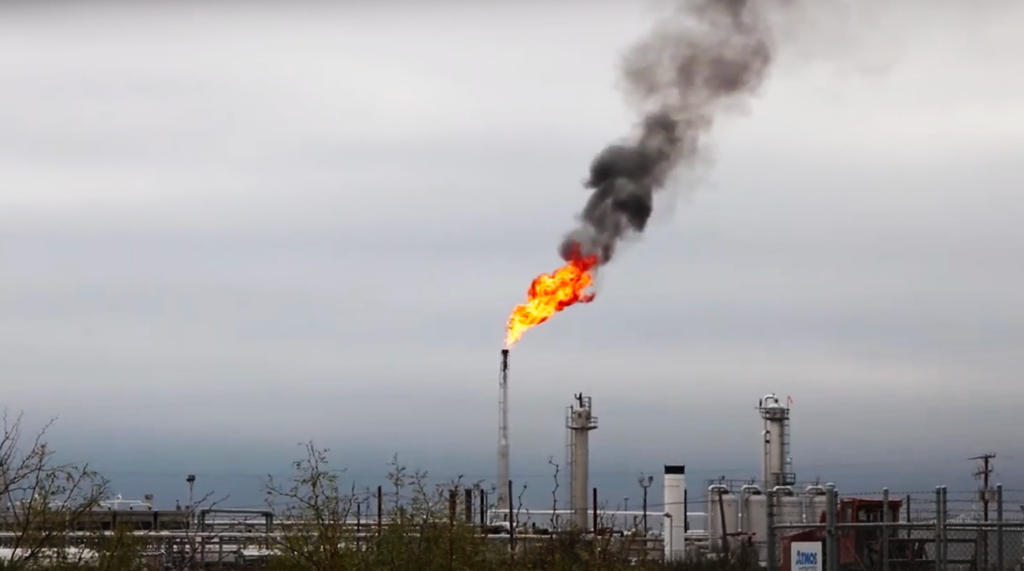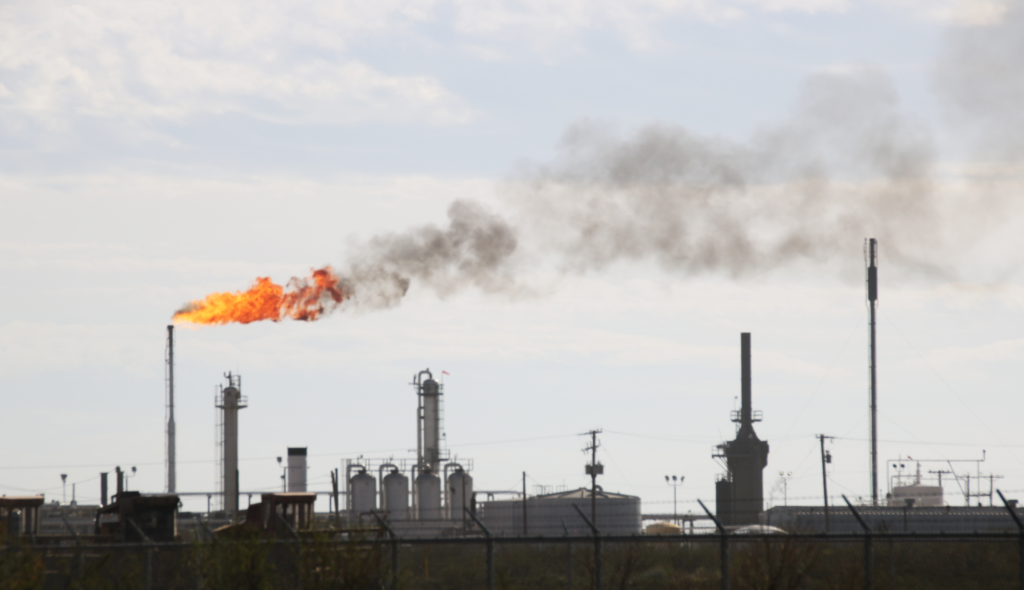When visiting oil and gas wells, flares are hard to miss. The flames light up their surroundings, make noise, and can throw off enough heat to be felt on your face away from the well’s property.
Ostensibly all of this serves a valuable purpose. Flares happen when operators have to release gas into the air, such as when pipes need to be emptied so repairs can be conducted. A properly operating flare burns the methane gas that wells produce, yielding carbon dioxide (CO2) and water. This is important because CO2 in the near term has a substantially less potent impact on global warming than methane. However, one of the most visible aspects of flaring has been relatively unaddressed: the smoke that flares produce.

Smoking Flares Produce Black Carbon
One might expect that smoke from a flare–essentially, an open flame–would be standard. However, proper flaring is not supposed to produce smoke. Flares can smoke for a variety of reasons. The two of most concern are insufficient air in the methane mixture or insufficient temperatures. Since wells don’t produce pure methane gas, flares burn a variety of different compounds. Even if wells did produce pure methane gas, flares would still burn a mixture of methane gas and air. As the amount of air in the stream of gas increases, the efficiency with which the flare is able to burn the methane gas increases (presuming that temperatures are sufficiently high in the flare to combust this mixture). In either case the flare isn’t able to fully burn the gas. The only partially burned gas becomes black carbon (soot or ash) which then gives smoke its distinct color.
Black Carbon Threatens Communities and the Climate
Black carbon is estimated to be responsible for 15% to 30% of global climate change. A major reason black carbon has such a significant climate impact is that it lowers the albedo of the Earth’s surface, increasing heat absorption. Just like methane, black carbon has a short lifespan in the atmosphere, and thus reducing black carbon can have rapid effects on slowing warming. Beyond its environmental impacts, black carbon harms human health. It is linked with harms including but not limited to cardiovascular (heart) disease, birth defects, cancer, and early death.
Due to the threat posed to both the climate and public health, the federal government has regulations intended to limit black carbon from flaring. The most important of these regulations is the EPA’s 40 CFR 60.18 regulation which prohibits flares from smoking for more than five minutes during any given two hour period. Such a simple regulation should make enforcement easy. Just watching a flare for two hours, and seeing if it smokes for more than five minutes, is sufficient evidence to issue a violation. The process is so easy that the measuring method (called Method 22 by the EPA) doesn’t even require a certification. It can be done with two stopwatches and the naked eye by anyone.
One would think that the ease with which this regulation could be enforced would scare operators into compliance. Unfortunately, like most other federal air pollution regulations, the EPA has delegated the enforcement of this guideline to the Texas Commission on Environmental Quality (TCEQ). The list of TCEQ enforcement shortcomings is long. A substantial amount of ink has been spilled by Earthworks and other organizations on the lack of oversight that Texas regulators conduct on flaring. Black carbon is yet another shortcoming to add to that list.

Texas Doesn’t Make an Effort to Control Smoking Flares
In her various visits to oil fields all around Texas, Earthworks’ certified optical gas imaging thermographer, Sharon Wilson, has documented numerous smoking flares. In many cases these flares have smoked for more than five continuous minutes.
In one particularly egregious instance, Sharon documented a flare at a gas plant owned by Energy Transfer Partners smoking for over 30 minutes. The smoke plume from the flare was so dense that Sharon called the TCEQ directly so that it could be addressed as rapidly as possible. When she returned two days later, the flare was still smoking. Again, the flare smoked for the entirety of Sharon’s 30-minute visit to the site. When TCEQ contacted Energy Transfer Partners (nine days after Sharon’s urgent phone call), the company confirmed that the flare had in fact been smoking. Despite this the TCEQ did not issue any violations because — per Energy Transfer Partners — the smoking had occurred during a start up of equipment. This sort of nebulous get-out-of-jail-free card is common in TCEQ policy and often undermines meaningful enforcement, harming local residents and the global climate in the process
Texas Refuses to Link Fossil Fuels and Black Carbon
The TCEQ appears to consistently underappreciate the impact black carbon has on our environment, but even when the TCEQ does acknowledge black carbon as a pollutant, the agency generally avoids naming fossil fuels as a source of black carbon. For instance, in 2021, the TCEQ published a report on black carbon in Houston and El Paso, two cities with major oil and gas presences. Despite this, the TCEQ intentionally engineered the study in order to avoid even acknowledging black carbon from fossil fuels. They used a unique testing system that entirely omits black carbon from oil and gas from their results. Instead, they turned their sights towards wildfires and dust storms. While these are sources of black carbon, even the EPA acknowledges fossil fuels as a major source of black carbon across the country.
Unfortunately, the TCEQ’s insistence on under-evaluating the contribution of fossil fuels to black carbon emissions is not confined to just that study. In other documentation, when listing major sources for a variety of pollutants, oil and gas is mentioned as a source of several other pollutants. However, the source of black carbon is listed as simply “incomplete combustion”. Such a statement — while technically correct — seems to intentionally downplay the role that oil and gas plays in black carbon pollution and the harm it causes.
The last time the TCEQ addressed smoking flares directly (which was 12 years ago), they issued suggestions on how to operate flaring equipment to minimize smoke. Based on Earthworks’ findings in the field in Texas, those suggestions don’t appear to have been adopted by many oil and gas operators, and now that report has been removed from TCEQ main site and put in an archive.
The TCEQ Can — and Should — do Better
While not sufficient to totally stop black carbon pollution, federal rules on black carbon from oil and gas are clear and simple to enforce. If two different videos from a certified optical gas imaging thermographer documenting more than 5 minutes of continuous smoke each accompanied by an affidavit signed by Sharon Wilson so that they could be used in court are insufficient to result in a violation for an operator, it’s difficult to imagine what it would take for TCEQ to issue a black carbon-related violation to a Texas oil and gas operator. Anyone who has spent time examining Texas oil and gas is likely used to the TCEQ being — at best — ineffective at enforcing environmental regulation. However, it’s especially disheartening to see the TCEQ failing to uphold the EPA’s simple regulation.
